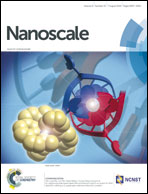Electrochemical preparation of vertically aligned, hollow CdSe nanotubes and their p–n junction hybrids with electrodeposited Cu2O†
Abstract
Vertically aligned, hollow nanotubes of CdSe are grown on fluorine doped tin oxide (FTO) coated glass substrates by ZnO nanowire template-assisted electrodeposition technique, followed by selective removal of the ZnO core using NH4OH. A detailed mechanism of nucleation and anisotropic growth kinetics of nanotubes have been studied by a combination of characterization tools such as chronoamperometry, SEM and TEM. Interestingly, “as grown” CdSe nanotubes (CdSe NTs) on FTO coated glass plates behave as n-type semiconductors exhibiting an excellent photo-response (with a generated photocurrent density value of ∼470 μA cm−2) while in contact with p-type Cu2O (p-type semiconductor, grown separately on FTO plates) because of the formation of a n–p heterojunction (type II). The observed photoresponse is 3 times higher than that of a similar device prepared with electrodeposited CdSe films (not nanotubes) and Cu2O on FTO. This has been attributed to the hollow 1-D nature of CdSe NTs, which provides enhanced inner and outer surface areas for better absorption of light and also assists faster transport of photogenerated charge carriers.


 Please wait while we load your content...
Please wait while we load your content...